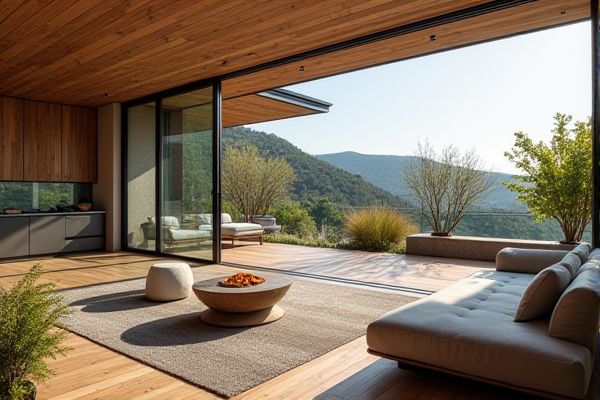
Organizing a small terrace requires strategic use of space with compact, multifunctional furniture and vertical gardening to maximize utility and aesthetics. Your choices differ significantly for a large terrace, where zoned areas for lounging, dining, and planting allow for expanded comfort and personalization; explore the rest of the article to optimize your terrace size effectively.
Table of Comparison
| Aspect | Small Terrace | Large Terrace |
|---|---|---|
| Space Utilization | Compact, efficient use of limited space | Ample space for diverse arrangements and zones |
| Furniture | Minimal, multi-functional pieces | Variety of furniture including dining sets and lounges |
| Plant Selection | Small pots, vertical gardens, space-saving plants | Larger pots, trees, shrubs, varied plant types |
| Functionality | Focused on relaxation or small gatherings | Supports entertainment, dining, gardening, multiple uses |
| Maintenance | Lower maintenance due to fewer elements | Higher maintenance due to larger area and variety |
| Privacy | Limited privacy, requires creative screening | Better options for privacy screens and separation |
Understanding Small vs Large Terrace Spaces
Small terraces demand strategic organization to maximize limited space, using vertical gardening and multifunctional furniture to enhance usability. Large terraces offer expansive opportunities for zoning, allowing distinct areas for dining, lounging, and planting, which improves both aesthetics and functionality. Efficient organization in any terrace size focuses on optimizing spatial flow and selection of appropriate-scale furnishings to suit lifestyle needs.
Key Differences in Terrace Organization
Small terrace organization prioritizes maximizing limited space through vertical gardening, compact furniture, and multifunctional decor, promoting efficiency and coziness. Large terrace organization allows for diverse zones such as dining, lounging, and gardening, enabling more elaborate landscaping and social areas. The key differences lie in space utilization strategies, with small terraces emphasizing minimalism and large terraces focusing on expansive design and varied usage.
Space Planning Strategies for Small Terraces
Maximizing functionality in small terraces requires efficient space planning strategies such as using vertical gardens, foldable furniture, and multi-functional seating to optimize limited square footage. Incorporating built-in storage solutions and selecting compact, modular pieces enhances usability while maintaining an open feel. Proper zoning of areas for dining, lounging, and greenery ensures small terraces serve multiple purposes without overcrowding.
Optimal Layout Designs for Large Terraces
Large terraces offer extensive space for diverse layout designs that balance functionality and aesthetics, incorporating zones for dining, lounging, and gardening. Optimal large terrace designs focus on creating seamless transitions between areas, maximizing natural light, and using multi-level platforms or partitions to define spaces without overcrowding. Your large terrace can be transformed into a versatile outdoor living area with strategic furniture placement, greenery, and lighting to enhance comfort and usability.
Furniture Selection: Small vs Large Terrace Needs
Small terraces require compact, multifunctional furniture to maximize limited space while maintaining comfort and style. Large terraces offer the flexibility to incorporate diverse furniture zones such as dining areas, lounge sets, and storage units, enhancing outdoor living versatility. Your furniture selection should align with terrace size to optimize functionality and aesthetic appeal effectively.
Maximizing Storage Solutions for Any Terrace Size
Maximizing storage solutions for any terrace size requires strategic planning tailored to the available space. On a small terrace, vertical storage options like wall-mounted shelves and foldable furniture help utilize limited areas efficiently. Your large terrace can accommodate bulkier storage units and multifunctional outdoor furniture, balancing aesthetic appeal with practical organization.
Plant Arrangement Tips for Small and Large Terraces
Optimizing plant arrangements on your terrace requires tailoring strategies to its size; small terraces benefit from vertical gardening and compact container plants to maximize space and maintain accessibility. Large terraces provide opportunities for diverse plant groupings, allowing for distinct zones with varied heights, textures, and colors to create a lush, multi-dimensional environment. Arranging plants according to their sunlight needs and growth habits ensures healthy growth and an aesthetically pleasing terrace design.
Lighting Ideas for Different Terrace Dimensions
Small terraces benefit from compact, multi-functional lighting such as string lights and wall-mounted sconces that maximize space without clutter. Large terraces allow for layered lighting designs including pendant lights, floor lamps, and landscape lighting to create distinct zones and ambiance. Solar-powered and dimmable LED options enhance energy efficiency while adapting brightness to terrace size and use.
Seasonal Decor Approaches for Small and Large Terraces
Seasonal decor on a small terrace requires strategic use of compact, multi-functional furniture and vertical planters to maximize limited space, creating a cozy yet stylish atmosphere. Large terraces offer the flexibility to incorporate expansive flower beds, statement outdoor rugs, and larger furniture arrangements that highlight seasonal colors and textures with more visual impact. You can enhance any terrace size by selecting versatile decor pieces that transition smoothly between seasons, ensuring a fresh and inviting outdoor space year-round.
Maintenance and Upkeep Considerations
A small terrace requires less maintenance due to limited space, making tasks like cleaning, plant care, and furniture upkeep more manageable and time-efficient. In contrast, a large terrace demands more effort and resources for regular maintenance, including extensive gardening, frequent furniture cleaning, and surface upkeep to prevent wear and damage. Choosing the right terrace size impacts long-term maintenance costs and the time commitment needed to keep the outdoor area attractive and functional.
 homyna.com
homyna.com